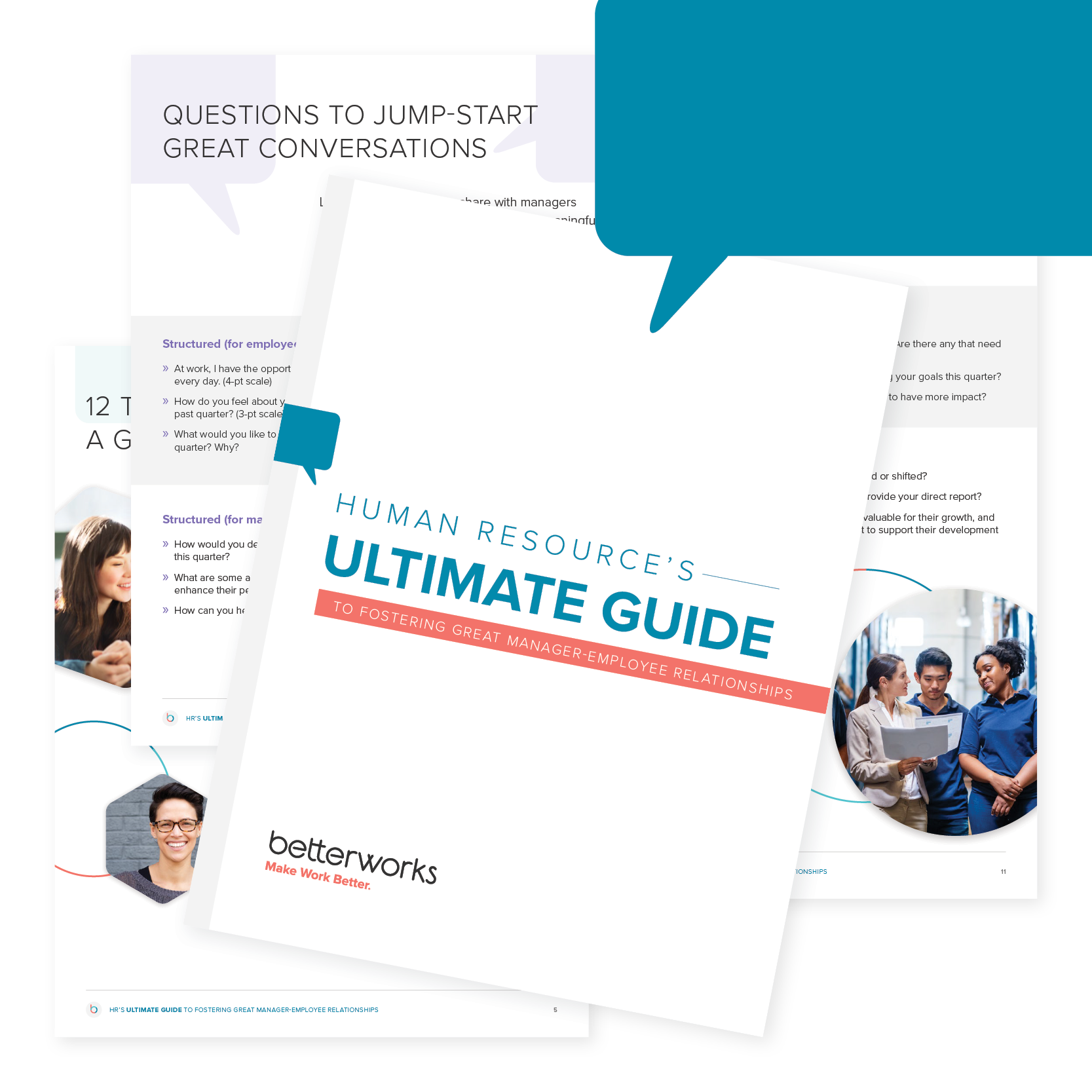The right performance management approach can transform ambitious performance goals into reality. But that means employees need to feel like your performance management system is working for them, not against them.
Yet, according to our 2024 State of Performance Enablement report, many employees don’t feel supported by their organization’s performance management processes. Nearly half (44%) of employees give their current performance management system a failing grade, compared to only 12% of executives.
Let’s explore different approaches to performance management to help you close this gap in your organization, so you can enable employees to reach their full potential.
Understanding performance management
Performance management should be more than just keeping a record of how people did in the past. It’s better seen as an ongoing effort to help everyone in your organization understand their roles, foster their development, and promote accountability.
Performance management serves several business purposes. The approach you choose will depend on your primary goals. Here are some potential goals to achieve:
- Align employee efforts with business goals: Match individual goals with broader business objectives, driving the organization toward success.
- Develop employees: Encourage regular feedback and performance evaluations to identify employees’ strengths and areas needing improvement.
- Improve productivity: Set clear expectations and provide ongoing support to improve employee productivity and efficiency.
- Engage and motivate: Provide regular feedback and recognition to help employees feel more engaged and motivated in their daily work.
Different approaches to performance management can influence how well these goals are achieved. By understanding and implementing the right performance management approaches, you can create a supportive environment that nurtures talent, drives performance, and ultimately leads to business success.
Traditional vs. modern performance management approaches
Performance management as an intentional program gained momentum during World War II, when the military used performance evaluations to identify and promote good performers.
By the 1960s, companies like General Electric adopted performance management methods to reduce employee turnover and foster growth. This trend continued into the 1970s as organizations refined merit-based pay in response to economic challenges.
By the 2010s, the focus shifted towards more agile performance management, emphasizing more frequent check-ins. This approach has further evolved into what we now call continuous performance management, in which managers act as coaches, consistently guiding and developing their employees.
Annual performance reviews
Traditionally, organizations have relied on static, typically annual, performance reviews to assess employee performance. This approach involves evaluating an employee’s performance over the past year and setting goals for the future.
One advantage of annual performance reviews is that they provide a formal, documented evaluation process. This structured approach helps you make sure that each employee’s performance is assessed in a consistent and organized manner.
However, annual performance reviews have several disadvantages. Since they only happen once a year, they tend to be disconnected from day-to-day performance, making it difficult to address performance issues and make adjustments in real-time. This lack of feedback can make employees feel anxious and stressed. They may feel unsure about how well they are doing and what feedback they’ll get during that high-stakes review.
Continuous feedback and check-ins
Modern performance management approaches emphasize continuous feedback and more frequent check-ins between employees and managers. This method encourages ongoing communication, allowing for real-time feedback and timely adjustments to goals and performance.
Regular feedback and check-ins enhance employee engagement and development. Maintaining open lines of communication helps employees feel more connected and supported, which fosters their growth and performance.
This approach also fosters a culture of learning and growth, encouraging employees to proactively seek ways to improve their skills. Continuous feedback also helps to find and fix performance problems quickly, addressing any problems that arise before they get worse. Employees who receive conversations and feedback are three times more likely to feel they can perform their work well, according to our 2024 State of Performance Enablement report.
However, implementing continuous feedback does come with some challenges. It requires a cultural shift and commitment from both managers and employees. Both parties need to be committed to regular, helpful communication, which can be a big shift from the annual performance review and feel overly time-consuming.
Managers need to be trained to ensure check-ins are productive. The most effective feedback is timely, relevant, and focused on learning, not personal criticism, said Caitlin Collins, organizational psychologist and program strategy director at Betterworks. Creating a safe environment where feedback is seen as a tool for improvement makes the process positive and useful for everyone involved.

Get your managers started on better conversations
4 key performance management frameworks
There are many ways to manage performance, but some will be better than others at improving employee performance in your company. By looking at your options, you can find the best approach to meet your specific business goals
Choosing the right framework can help you create a motivated, high-performing workforce that drives your company forward.
Objectives and key results (OKRs)
The OKR framework is a goal-setting approach that aligns individual objectives with the organization’s strategic goals. It involves defining specific, measurable goals and tracking progress through key results.
OKRs align individual goals with company goals, ensuring everyone is working towards the same outcome. This framework also provides clear, measurable targets, making it easier for employees to see what they need to do and track their progress. Finally, OKRs help employees focus on their goals and take responsibility for their outcomes, leading to higher productivity and ownership.
Management by objectives (MBOs)
The management by objectives (MBO) approach to performance management focuses on setting clear, achievable goals for employees and assessing performance based on their completion. This approach discourages micromanagement of how work is performed, allowing employees to take ownership of their performance.
An MBO framework motivates and engages employees by giving them clear targets to strive for and a sense of purpose in their work, which boosts overall job satisfaction. It encourages accountable goal-setting, prompting employees to set clear objectives and take responsibility for achieving them.
Balanced scorecard
The balanced scorecard approach evaluates performance from many different angles, including financial, customer, internal processes, and learning and growth. This comprehensive view translates complex business goals into performance goals for teams and individual contributors.
This approach provides a holistic view of performance, giving a big-picture snapshot of the organization’s overall performance. It also balances financial and non-financial metrics, helping employees see how their contributions drive revenue and serve customers, as well as how they enrich their teams and their own careers.
360-degree feedback
The 360-degree feedback model gathers performance feedback from multiple sources, including peers, supervisors, and team members. This approach is meant to provide a well-rounded view of an employee’s performance and foster a culture of continuous improvement.
The 360-degree review model helps employees become more self-aware by providing nuanced perspectives on their performance, bringing clarity to their strengths and areas to improve. However, it can sometimes make employees feel defensive if feedback isn’t constructive, and the process can be time-consuming and resource-intensive.

Evaluating your performance management approach
Tailoring your performance management approach to your organization’s unique needs supports employee growth, aligns performance with business objectives, and fosters a productive work environment. This careful evaluation helps create a performance management system that truly enhances your team’s effectiveness and contributes to your company’s success.
What makes performance management exceptional?
In today’s workplace, a few key qualities can make performance management truly exceptional.
First, collaboration is essential. Many of your team members work in groups, but not everyone has a system for using feedback from peers and teams in their performance reviews. By gathering feedback from various sources, you can make evaluations fairer and foster a sense of inclusion. This way, your evaluations will be more accurate and reflect each employee’s true contributions.
As an HR leader, you know that managers play a crucial role in communicating company values and strategies. Your performance management software should help managers by offering guidance and templates for constructive feedback and conversations with their teams.
Regular check-ins build trust and transparency, helping employees feel more confident in receiving support to improve their performance. This open communication also helps align individual goals with company goals, boosting your team’s sense of purpose and overall performance.
Assess your current process against a proven list of qualities that make performance enablement exceptional to identify gaps and set goals for improvement.
Aligning with business goals
Aligning your performance management approach with your business goals is crucial for achieving strategic success. Make sure that your performance management approach supports your organization’s goals and drives desired outcomes.
Say business leaders set a strategic goal to improve customer satisfaction by 20% over the next year. To achieve this, customer service managers set clear key performance indicators (KPIs) for their teams, such as reducing response times and resolving issues on the first call. They track progress with monthly check-ins, provide feedback on employee performance, and evaluate outcomes quarterly.
Now, consider two different ways to manage this process. With traditional annual reviews, managers might miss out on addressing issues promptly, causing delays in improvement. On the other hand, modern performance management with continuous feedback and regular check-ins allows managers to adjust strategies in real time, keeping everyone aligned and motivated. This proactive method not only helps the team perform better but also helps the business achieve its strategic goals more effectively.
Final thoughts: Choosing the right performance management approach
Choosing the right performance management approach is essential for unlocking your workforce’s potential and driving business success. Think about your company’s unique needs, goals, and work environment when evaluating different ways to manage performance.
Whether you opt for traditional methods like annual reviews or modern approaches like continuous feedback, make sure that your strategy supports your overall business goals. Different performance management approaches support different goals, but the best models engage employees and put them on a path to continuous improvement.
Implementing the best performance management approach within your business improves employee performance, boosts engagement, and achieves organizational goals. Take the time to evaluate your current approach to measuring performance management, align it with your business goals, and make any necessary adjustments to drive success.
Want to learn more? Discover how performance enablement holds the key to organizational success.


